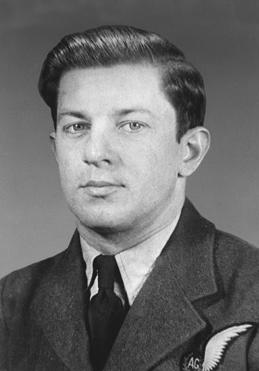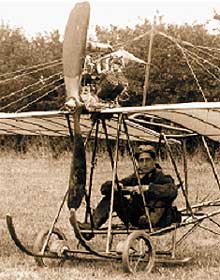
The Avro Anson is a British twin-engined, multi-role aircraft built by the aircraft manufacturer Avro. Large numbers of the type served in a variety of roles for the Royal Air Force (RAF), Fleet Air Arm (FAA), Royal Canadian Air Force (RCAF), Royal Australian Air Force and numerous other air forces before, during, and after the Second World War.

The Avro York was a British transport aircraft developed by Avro during the Second World War. The design was derived from the Avro Lancaster heavy bomber, several sections of the York and Lancaster being identical. Due to the importance of Lancaster production, York output proceeded slowly until 1944, after which a higher priority was placed upon transport aircraft.

Edwin (Ted) Essery Swales VC DFC was a South African pilot and Second World War hero. He was awarded the Distinguished Flying Cross and posthumously the Victoria Cross.

Andrew Charles Mynarski, VC was a Canadian airman and a recipient of the Victoria Cross, the highest award for bravery in the face of the enemy that can be awarded to British and Commonwealth forces. Mynarski was 27 years old and flew with No. 419 "Moose" Squadron, Royal Canadian Air Force during the Second World War when he died attempting to help rescue a trapped crew member. His Victoria Cross, which was awarded in 1946, was the last Victoria Cross received by any Canadian serviceman in the Second World War.

A bombardier or bomb aimer is the crew member of a bomber aircraft responsible for the targeting of aerial bombs. "Bomb aimer" was the preferred term in the military forces of the Commonwealth, while "bombardier" was the equivalent position in the United States Armed Forces.
Flight Sergeant Stanley James Woodbridge,, known as Stan Woodbridge, was a British Second World War recipient of the George Cross. He was born in Chelsea, London, and during the Second World War served as a member of the Royal Air Force Volunteer Reserve, with No. 159 Squadron RAF.

Harrogate (Stonefall) Cemetery is a Commonwealth War Graves Commission (CWGC) burial ground for the dead of the First World War and Second World War located on the outskirts of Harrogate in North Yorkshire, England.
Squadron Leader Henry Melvin "Dinghy" Young, was a bomber pilot in the Royal Air Force Volunteer Reserve during the Second World War.

Scottish Airlines (Prestwick) Limited was formed in 1946 as a subsidiary of Scottish Aviation Limited. The airline commenced worldwide passenger and cargo charter flights from bases at Prestwick and Stansted. It also participated in the Berlin Airlift, became a trooping carrier for the British Armed Forces, and began contract flights on behalf of Air France, British European Airways (BEA), Compagnie Belge des Transports Aériens, Iceland Airways and KLM.

On 15 January 1953, a twin-engined Vickers Valetta transport aircraft of the Royal Air Force (RAF), serial number VX562, collided over the Mediterranean Sea with a four-engined RAF Avro Lancaster maritime patrol aircraft. All 26 people on board both aircraft were killed.

Squadron Leader Edwin Rowland Moon DSO* was an English aviation pioneer who served in the Royal Naval Air Service and Royal Air Force during the First World War. He was a prisoner of war and he was twice awarded a DSO.

The aircrews of RAF Bomber Command during World War II operated a fleet of bomber aircraft carried strategic bombing operations from September 1939 to May 1945, on behalf of the Allied powers. The crews were men from the United Kingdom, other Commonwealth countries, and occupied Europe, especially Poland, France, Czechoslovakia and Norway, as well as other foreign volunteers. While the majority of Bomber Command personnel were members of the RAF, many belonged to other air forces – especially the Royal Canadian Air Force (RCAF), Royal Australian Air Force (RAAF) and Royal New Zealand Air Force (RNZAF). Under Article XV of the 1939 Air Training Agreement, squadrons belonging officially to the RCAF, RAAF, and RNZAF were formed, equipped and financed by the RAF, for service in Europe. While it was intended that RCAF, RAAF, and RNZAF personnel would serve only with their respective "Article XV squadrons", in practice many were posted to units of the RAF or other air forces. Likewise many RAF personnel served in Article XV squadrons.

The Avro Lancaster PA278 disappearance involved Avro Lancaster Mk.I PA278, "F for Freddie", operated by No. 103 Squadron RAF of Bomber Command just after the end of the Second World War.

The Dunbeath air crash involved the loss of a Short S.25 Sunderland Mk. III that crashed in the Scottish Highlands on a headland known as Eagle's Rock near Dunbeath, Caithness, on 25 August 1942. The crash killed 14 of 15 passengers and crew, including Prince George, Duke of Kent, who was on duty as an Air Commodore in the Royal Air Force on a mission to Reykjavík; a message of condolence was proposed in Parliament by the British Prime Minister. A Royal Air Force Board of Inquiry determined that the crash was the result of a navigational error by the crew.
Pembroke Military Cemetery Malta is a burial ground for military personnel and their dependants. It is located close by the former St Patrick's Barracks in the Pembroke Council area, on a minor road.

The Elvetham air crash occurred on 5 October 1945 when a Consolidated Liberator GR.VI aircraft, serial number KG867, of 311 Squadron Royal Air Force crashed at Elvetham, east of Hartley Wintney, Hampshire, following a fire in one of its engines and fuel starvation to another.

The 1975 Żabbar Avro Vulcan crash was a military aviation accident that occurred in Malta on 14 October 1975 when an Avro Vulcan B.2 bomber crashed after an aborted landing at RAF Luqa. The aircraft crashed in a residential area in Żabbar, and five crew members and one civilian on the ground were killed. The two pilots managed to eject and survived the accident. The crash caused extensive damage to many buildings in Żabbar.

The 1952 Luqa Avro Lancaster crash was a military aviation accident that occurred in Malta on 30 December 1952 when an Avro Lancaster bomber crashed shortly after takeoff from RAF Luqa into a residential area in Luqa. Three of the four crew members on board the aircraft and a civilian on the ground were killed. The crash also caused extensive property damage. The cause of the crash was engine failure.

The Imtarfa Military Cemetery is a cemetery in Mtarfa on Triq Buqana in the Northern Region of Malta. The cemetery contains over 1,400 interments and commemorations including 254 graves of military personnel killed in the country in World War I and World War II. Many graves are marked by Commonwealth War Graves Commission (CWGC) gravestones. Some of the CWGC graves are damaged due to bombing of a nearby airfield in the Second World War.

The 1946 United States Air Force C-47 crash, known in China as the April 8 Incident, was the crash of US Army Air Force C-47B-1-DL from Chongqing to Yan'an that struck a mountain in Shaanxi, China, killing all four crew members and 13 passengers, including several top Communist Chinese leaders.

















